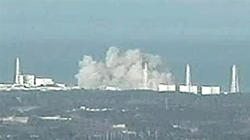Problematic design of Japan's imperiled nuclear reactors common in U.S.
 The nuclear power disaster triggered by the massive earthquake and tsunami that struck Japan on Friday is worsening by the day and raising concerns about nuclear safety in the United States.
The nuclear power disaster triggered by the massive earthquake and tsunami that struck Japan on Friday is worsening by the day and raising concerns about nuclear safety in the United States.At the Fukushima 1 Nuclear Power Plant, which is one of the world's largest nuclear power stations, hydrogen explosions (photo above) have rocked two of the facility's three operating reactors, with a still-unknown amount of radiation released to the environment. Excessive hydrogen is created inside the reactor by a reaction involving the alloy used to clad fuel rods.
The cooling system at the plant's third operating reactor has also failed. (The facility has a total of six reactors, but three were down for maintenance at the time of the earthquake.) Click here for a video of today's second hydrogen explosion.
The New York Times reports that three workers from the Fukushima 1 plant are suffering from radiation sickness, while 22 residents from the area near the plant have showed signs of radiation exposure. In addition, 17 members of a U.S. Navy helicopter crew operating a relief mission from a ship off Japan's coast were exposed to radiation from the plant.
The failed reactors at the imperiled Fukushima plant are General Electric Mark I boiling water reactors. The Nuclear Information and Resource Service, a Maryland-based nuclear power watchdog group, points out [pdf] that nuclear experts have long raised concerns about that reactor's susceptibility to explosions and containment failures:
As early as 1972, Dr. Stephen Hanauer, an Atomic Energy Commission safety official, recommended that the pressure suppression system be discontinued and any further designs not be accepted for construction permits. Shortly thereafter, three General Electric nuclear engineers publicly resigned their prestigious positions citing dangerous shortcomings in the GE design.The following Facing South-created map, based on an NIRS release [pdf], locates the 23 GE Mark 1 reactors in the U.S. Click on the red pin marker for details, including the reactor's location, date it began operating and license renewal status. Note the proximity of several of the reactors -- including the two at Progress Energy's Brunswick plant in North Carolina -- to the Atlantic Coast.
An NRC analysis of the potential failure of the Mark I under accident conditions concluded in a 1985 report that Mark I failure within the first few hours following core melt would appear rather likely. In 1986, Harold Denton, then the NRC's top safety official, told an industry trade group that the "Mark I containment, especially being smaller with lower design pressure, in spite of the suppression pool, if you look at the WASH 1400 safety study, you'll find something like a 90% probability of that containment failing."
Tags
Sue Sturgis
Sue is the former editorial director of Facing South and the Institute for Southern Studies.
